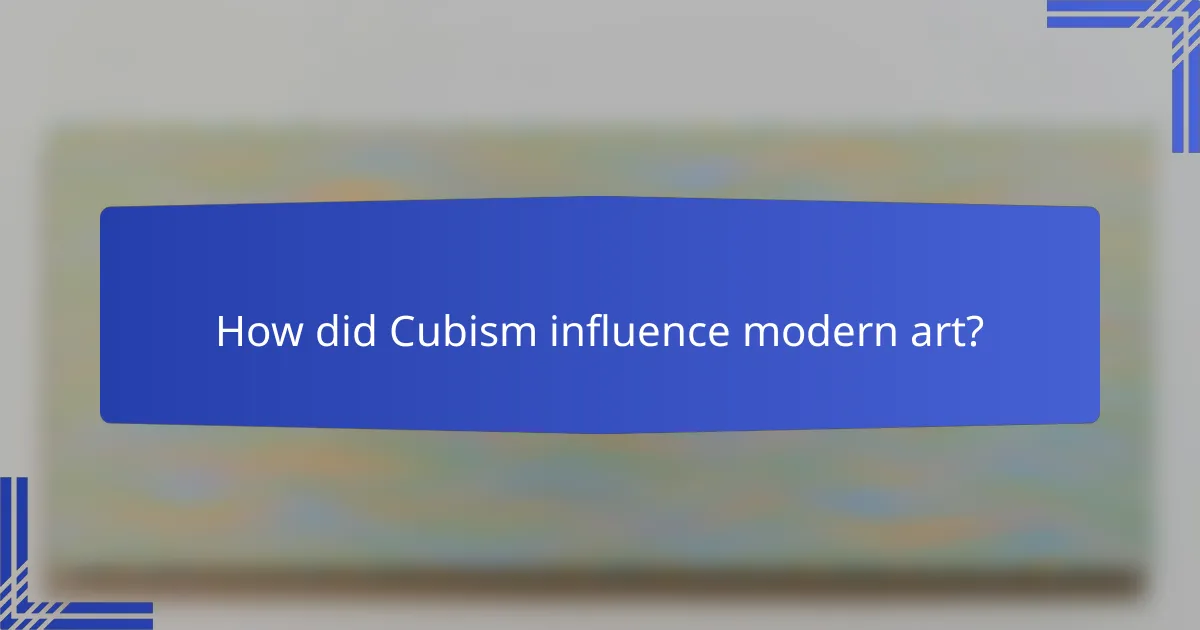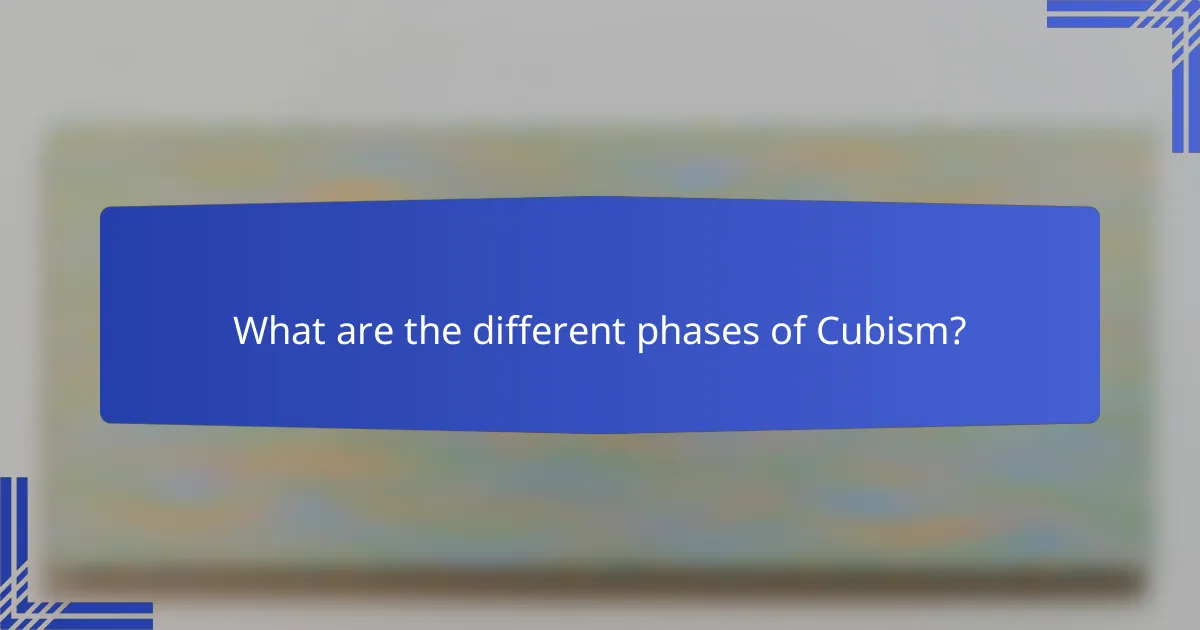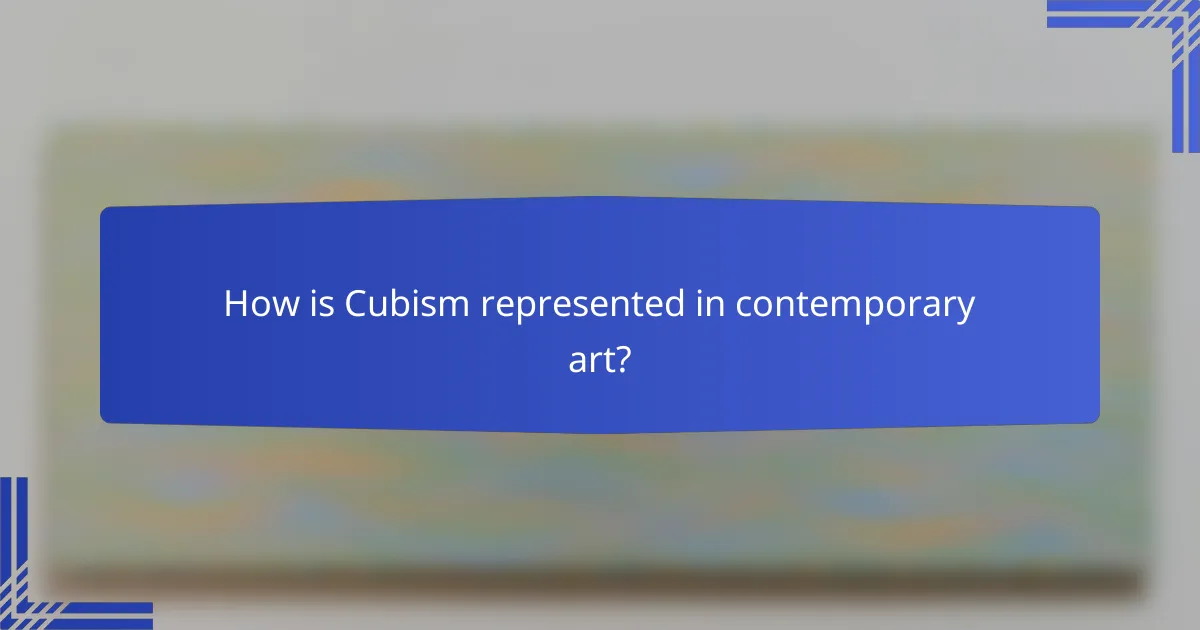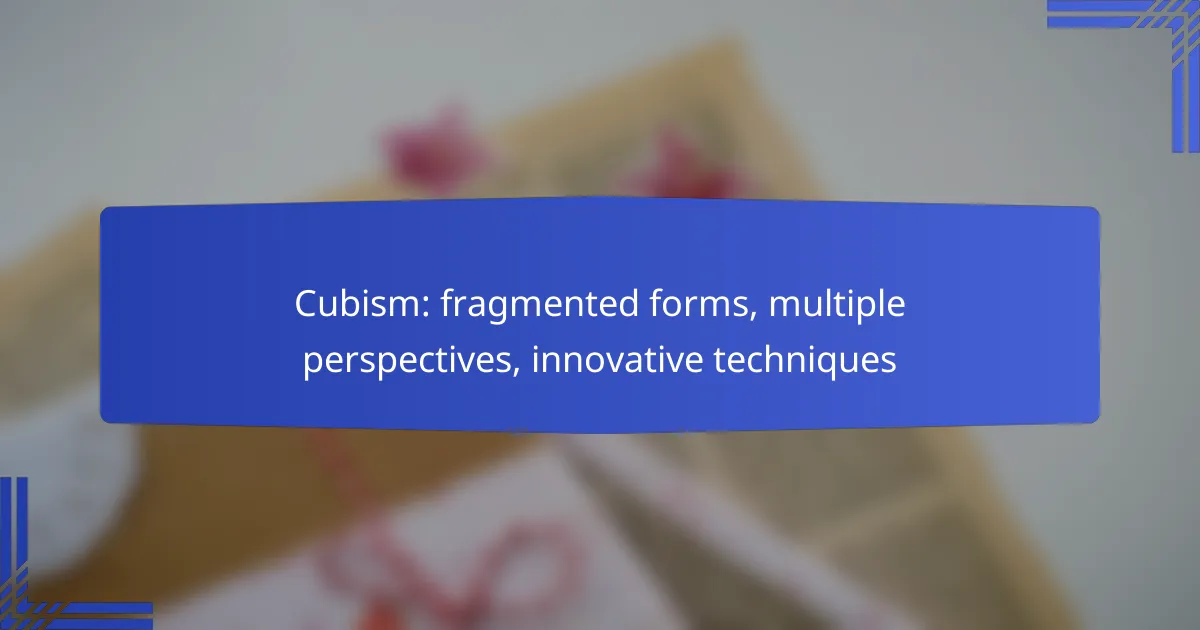Cubism revolutionizes artistic expression by deconstructing subjects into fragmented forms and showcasing multiple perspectives at once. This groundbreaking technique enables artists to portray reality in a more intricate and abstract way, moving beyond conventional representations and inviting viewers to engage with art from various angles.

How does Cubism transform artistic expression?
Cubism transforms artistic expression by breaking down subjects into fragmented forms and presenting multiple perspectives simultaneously. This innovative approach allows artists to depict reality in a more complex and abstract manner, challenging traditional representations.
Fragmented forms
Fragmented forms in Cubism involve deconstructing objects into geometric shapes and planes. This technique emphasizes the two-dimensionality of the canvas, allowing viewers to perceive the subject from various angles at once. For example, a still life may appear as a collection of overlapping cubes and triangles, rather than a realistic portrayal.
Artists like Pablo Picasso and Georges Braque often used fragmented forms to convey movement and depth, creating a dynamic visual experience. This approach encourages viewers to engage with the artwork actively, piecing together the fragmented elements to form a cohesive understanding.
Multiple perspectives
Multiple perspectives in Cubism allow artists to present different viewpoints of the same subject within a single composition. This technique reflects the complexity of human perception, suggesting that reality is not fixed but rather subjective. For instance, a portrait might show a face from the front and side simultaneously, providing a richer narrative.
This method challenges the viewer to reconsider their understanding of space and form, making Cubism a revolutionary movement in art history. It invites an exploration of how we perceive the world, emphasizing that there are always multiple ways to interpret a single scene.
Innovative techniques
Cubism employs innovative techniques such as collage, which integrates various materials and textures into the artwork. This approach not only enhances visual interest but also blurs the boundaries between different artistic mediums. Artists often combined painting with elements like newspaper clippings or fabric, creating a multi-layered effect.
Another technique is the use of monochromatic color schemes, which helps to unify fragmented forms and draw attention to structure over color. By limiting the palette, artists focus on the interplay of shapes and lines, further emphasizing the abstract qualities of Cubism. These techniques collectively redefine how art can be created and experienced, pushing the boundaries of traditional artistic expression.

What are the key characteristics of Cubism?
Cubism is characterized by fragmented forms, multiple perspectives, and innovative techniques that challenge traditional representation in art. It breaks subjects into geometric shapes and interlocking planes, allowing viewers to see objects from various angles simultaneously.
Geometric shapes
In Cubism, artists utilize geometric shapes to deconstruct objects into their fundamental forms. This approach simplifies complex subjects, making them more abstract and open to interpretation. For example, a still life may be represented with cubes, spheres, and cones, emphasizing structure over realism.
Artists like Pablo Picasso and Georges Braque often employed sharp angles and flat surfaces, creating a sense of depth through the arrangement of these shapes. This technique invites viewers to engage with the artwork on a more conceptual level.
Interlocking planes
Interlocking planes are a hallmark of Cubist composition, where different facets of an object are depicted on a flat surface. This technique creates a layered effect, allowing various aspects of the subject to coexist within the same visual space. The overlapping planes can suggest movement and dynamism.
By using interlocking planes, artists can convey a sense of three-dimensionality while still adhering to a two-dimensional medium. This method challenges the viewer’s perception, encouraging them to explore the relationships between the planes and the overall form.
Simultaneous viewpoints
Simultaneous viewpoints involve presenting multiple perspectives of a subject within a single artwork. This characteristic allows the viewer to experience the object from various angles at once, breaking away from the constraints of traditional perspective. For instance, a portrait may show both the front and side of a face in one image.
This technique not only enhances the complexity of the composition but also reflects the way humans perceive the world. By merging different viewpoints, Cubism invites a more holistic understanding of the subject, challenging the notion of a singular reality.

Which artists are pivotal in the Cubism movement?
The Cubism movement was significantly shaped by a few key artists whose innovative techniques and unique perspectives transformed the art world. Among them, Pablo Picasso, Georges Braque, and Juan Gris stand out for their contributions to the development and evolution of Cubism.
Pablo Picasso
Pablo Picasso is often regarded as the father of Cubism, co-founding the movement alongside Georges Braque. His works, such as “Les Demoiselles d’Avignon,” exemplify the fragmented forms and multiple perspectives that define Cubism, breaking away from traditional representation.
Picasso’s style evolved throughout his career, incorporating elements of abstraction and surrealism. His ability to depict subjects from various angles within a single canvas challenged viewers’ perceptions and encouraged a new way of seeing art.
Georges Braque
Georges Braque played a crucial role in the development of Cubism, collaborating closely with Picasso to refine the style. His paintings often feature muted colors and geometric shapes, emphasizing the structural aspects of objects rather than their surface details.
One of Braque’s notable contributions is the introduction of collage techniques, which involved incorporating real materials into his artwork. This innovation expanded the boundaries of Cubism and influenced future artistic movements.
Juan Gris
Juan Gris is recognized for bringing a more structured and colorful approach to Cubism, often referred to as “Synthetic Cubism.” His works, characterized by vibrant colors and clear forms, offered a contrast to the earlier, more monochromatic styles of Picasso and Braque.
Gris’s use of collage and mixed media allowed him to create dynamic compositions that maintained the essence of Cubism while adding a unique flair. His contributions helped solidify Cubism’s place in modern art history, showcasing its versatility and enduring influence.

How did Cubism influence modern art?
Cubism significantly shaped modern art by introducing fragmented forms and multiple perspectives, encouraging artists to explore abstraction and new visual languages. This movement laid the groundwork for various artistic styles that followed, emphasizing the importance of innovative techniques in representation.
Foundation for abstract art
Cubism is often regarded as a cornerstone of abstract art, as it moved away from traditional representation to focus on shapes and forms. Artists like Pablo Picasso and Georges Braque broke subjects into geometric shapes, allowing for a more conceptual understanding of reality. This shift paved the way for later movements such as Abstract Expressionism and Minimalism.
By challenging the norms of perspective and form, Cubism encouraged artists to prioritize emotional expression over realistic depiction. This approach has influenced countless contemporary artists who continue to experiment with abstraction in their work.
Impact on design and architecture
The principles of Cubism have extended beyond painting into design and architecture, promoting a fragmented aesthetic that is evident in various structures and products. Architects like Le Corbusier and Frank Lloyd Wright incorporated Cubist ideas, emphasizing geometric shapes and open spaces in their designs. This has led to a more dynamic interaction between spaces and their occupants.
In product design, Cubism’s influence can be seen in furniture and consumer goods that embrace asymmetry and unconventional forms. Designers often draw on Cubist concepts to create visually striking items that challenge traditional notions of beauty and functionality.

What are the different phases of Cubism?
Cubism is primarily divided into two distinct phases: Analytical Cubism and Synthetic Cubism. Each phase showcases unique techniques and perspectives, reflecting the evolution of this innovative art movement.
Analytical Cubism
Analytical Cubism, developed between 1908 and 1912, focuses on breaking down objects into fragmented forms and analyzing their structure. Artists like Pablo Picasso and Georges Braque deconstructed subjects, presenting multiple viewpoints simultaneously on a flat surface.
This phase is characterized by a muted color palette, primarily using greys, browns, and ochres, which emphasizes form over color. The artwork often features overlapping planes and interwoven lines, creating a sense of depth and complexity.
When creating in this style, avoid excessive detail; instead, focus on the essence of the subject. A common pitfall is overcomplicating the composition, which can detract from the intended clarity of the fragmented forms.
Synthetic Cubism
Synthetic Cubism emerged around 1912 and marked a shift towards simpler shapes and brighter colors. This phase introduced mixed media and collage techniques, allowing artists to incorporate materials like paper and fabric into their works, thus expanding the boundaries of traditional painting.
In Synthetic Cubism, the emphasis is on constructing images rather than deconstructing them. Artists often used bolder colors and clearer outlines, making the compositions more accessible while still maintaining a sense of abstraction.
To effectively use Synthetic Cubism, experiment with different materials and textures. Avoid relying solely on paint; instead, consider layering various elements to create a dynamic visual experience. This approach can enhance the overall impact of your artwork and invite viewer interaction.

What are the prerequisites for understanding Cubism?
To understand Cubism, one should have a foundational knowledge of Impressionism and the early 20th-century art movements that preceded it. These contexts provide essential insights into the evolution of artistic techniques and perspectives that define Cubism.
Familiarity with Impressionism
Impressionism laid the groundwork for Cubism by challenging traditional artistic conventions, particularly in terms of light and color. Artists like Claude Monet and Pierre-Auguste Renoir focused on capturing fleeting moments and the effects of light, which influenced later movements.
Understanding Impressionism helps to appreciate how Cubist artists, such as Pablo Picasso and Georges Braque, moved beyond mere representation to explore fragmented forms and multiple viewpoints. This shift marked a significant departure from the realistic depictions of their predecessors.
Knowledge of early 20th-century art movements
Familiarity with other early 20th-century art movements, such as Fauvism and Expressionism, is crucial for grasping the innovations that Cubism introduced. These movements emphasized bold colors and emotional expression, paving the way for Cubist experimentation with form and perspective.
Recognizing the interplay between these movements can enhance one’s understanding of how Cubism emerged as a radical approach to visual representation. It is beneficial to explore how these influences shaped the techniques and philosophies of Cubist artists, allowing for a deeper appreciation of their work.

How is Cubism represented in contemporary art?
Cubism is represented in contemporary art through its innovative techniques that emphasize fragmented forms and multiple perspectives. Artists today continue to explore these concepts, often blending them with modern mediums and technologies to create dynamic visual experiences.
Influence on digital art
The influence of Cubism on digital art is evident in the way artists utilize software to manipulate shapes and perspectives. Digital tools allow for the deconstruction of images, enabling creators to explore various viewpoints simultaneously, much like traditional Cubist painters did.
For example, artists can use 3D modeling software to create layered compositions that reflect Cubist principles. This approach not only enhances visual depth but also invites viewers to engage with the artwork from multiple angles, fostering an interactive experience.
When creating digital art inspired by Cubism, consider experimenting with collage techniques and geometric shapes. Avoid overly complex designs that may confuse the viewer; instead, aim for clarity in the fragmentation to maintain the essence of Cubist aesthetics.
